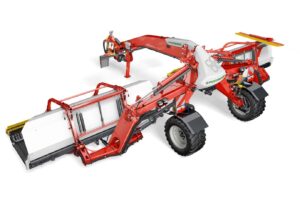FarmDroid is the latest in automated solutions
Which vegetable farmer would not like a way to control weed without using poisons? In comes the FarmDroid! Two Danish farming brothers, Jens and Kristian Warning, have developed a robot to do the work. And that is not all – the robot can also plant seeds and it runs on solar power! So, no fuel bill and no pesticide bill.
The FarmDroid uses ultra-accurate GPS to record exactly where it places each seed. Then on each subsequent weeding pass, it knows where the crop plants should be and works around them. It uses hoes shares between each row and the blades slice off anything in the row between crop plants.
This approach means it does not need any high-definition cameras and complex computers to identify and target weeds, allowing it to start the weeding process even before crop emergence. With in-row and inter-row action it does the complete job, working up to within 5 mm of each seedling between the rows and 20 mm in the row.
The whole machine weighs 800 kg.
Sugar beet farmers who tried out the first machine reported sugar beet yield increases of 40 to 60% over tractor-hoed crops. They believe that is due to the combination of precise seed placement and intra-row weed control making for uniform crop development.
Mounted atop the machine’s steel frame are four solar panels that charge two lithium-ion batteries. On a full charge, it can operate continuously for 24 hours, stopping only when the batteries are flat, at which point it will apply the brakes and wait for the sun to rise.
It can handle around 6 ha per day.
The two Danish brothers built the first prototypes with the help of some robotics specialists in their farm workshop. Launched at Agritechnica 2019, the FarmDroid is now produced at a dedicated manufacturing complex and more than 250 machines are already out working across northern Europe.
FarmDroid will be distributed by Opico.
“FarmDroid has come up with a unique solution that is suited to large and small-scale farming systems,” claims Opico Managing Director James Woolway. “Our distribution network, parts and technical teams are more than capable of backing up the tried and tested product, so it’s a great fit.”
South African farmers will have to come up with around R1,2 million to import a six-row version of one of these beauties with a few extra bucks for a RTK base station. The machine will be on the Opico stand at the LAMMA show. (Source: Farmers Weekly – UK)
New cutting system for Krone wagons
Krone has developed a new cutting system for their forage wagons which will prevent uncut material from escaping. The SplitCut cutting system inside the latest ZX forage wagons is designed to prevent uncut material from flowing over the rotor ends into the wagon.
At the same time the system offers greater precision, gentle crop handling and reduced input power.
With the SplitCut edge cut system, the outer rotor star is completely isolated from the loading space by side partitions. Thanks to this technology, it is ensured that no uncut forage gets into the hold, even at the outer edge of the rotor.
The harvested crop is divided at the first knife and conveyed forward again via the conveyor tines; two crop deflectors take care of the transfer to the centre of the rotor, where the forage is cut and transferred to the loading area.
The new cutting system benefits from beefier individual knife protection system components and the twice tempered blades are said to be more resilient to stress and strain.
Optimised rotor rpm, a new ZX option, allows the rotor speed to be reduced when operating the wagon behind less powerful (<184 kW) tractors or when harvesting thin swaths. (Source: profi)


MERGENTO VT 9220: Pöttinger launches a new belt-type rake
Grassland specialist Pöttinger has added yet another new product to its extensive grassland range: The new MERGENTO VT 9220 belt-type rake (with working widths of up to 9,2 metres for a central swath and 8,7 metres for a side swath) is designed for alfalfa, clover, and a wide variety of crops from permanent grassland to straw.
MERGENTO collects the forage using the pick-up. Meanwhile, dirt and stones remain on the ground. Without further contact with the ground, cross conveyor belts transport the forage to the swath.
Especially with leafy, dry crops, the Pöttinger belt rake minimizes disintegration losses because the forage is not raked across the ground. The overall result is more energy, more crude protein, and less crude ash in the forage.
Optimum crop flow
The heart of the MERGENTO is the conveyor unit. The perfectly coordinated system ensures a consistent flow of forage and perfectly formed swaths, even with short crop material. The conveyor unit consists of the pick-up, the crop press roller, and the cross-conveyor belt.
The six-row controlled pick-up delivers maximum collection performance with minimum forage contamination. The crop is gently collected from the ground by the successive pick-up tines and fed to the cross-conveyor belt. The cam track makes the tines retract just before the belt.
The transfer point is 120 mm higher than the cross-conveyor belt. This allows the forage to fall freely onto the conveyor belt. In addition, the flow of crop pushes the forage onto the belt.
The conveyor unit also operates reliably when driving downhill and with a short cut crop. The chassis rollers are positioned very close to the point the tines contact the crop and ensure perfect ground tracking.
The complete freedom of movement provided by the centre pivot mounting of the belt units ensures constant weight alleviation over the entire working width. It is also the basis for 3D ground tracking. The ingenious design of the boom with three hydraulic cylinders reacts in a split second to any bumps in the ground.
In the centre-swath mode, the vertical freedom of movement is +475 mm to -195 mm, while lateral float is +30 degrees to -13 degrees. The inclination in the direction of travel can move from +11,5 to 0 degrees.
The MERGENTO switches the cross conveyor belts off automatically at the headland and start running automatically at the beginning of the next pass. This system guarantees each swath starts and finishes tidily. It also saves a lot of time because there is no need to empty the cross-conveyor belt at the end of the swath. The delay time for switching the conveyor belts on and off can be conveniently adjusted using the terminal in the tractor cab.
Convenient operation and maximum flexibility
The direction of rotation and the position of the two cross conveyor belts can be adjusted from the comfort of the tractor cab. Depending on the shape of the field, the volume of forage and the follow-up harvesting machine, the new MERGENTO VT 9220 can place a centre swath, swaths to the left or right, two single swaths, convey from the inside out, and even load forage for a short period.













